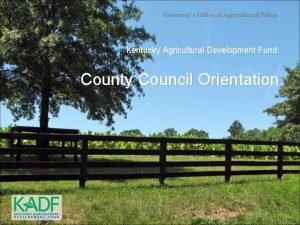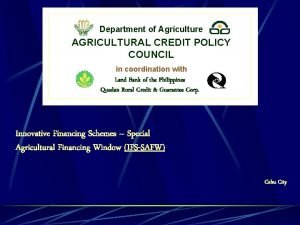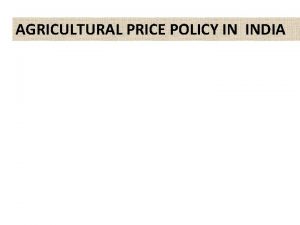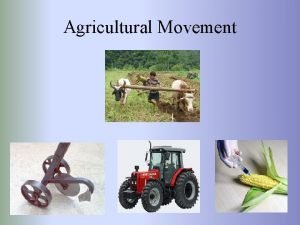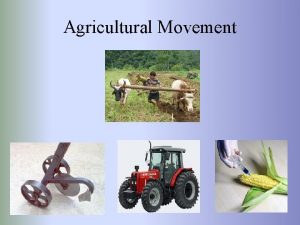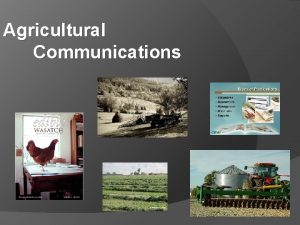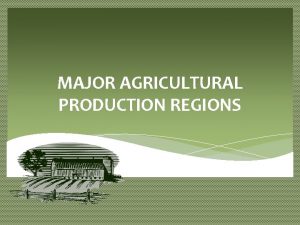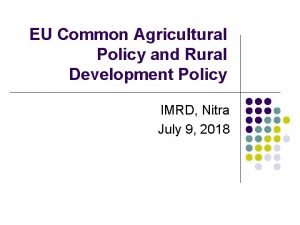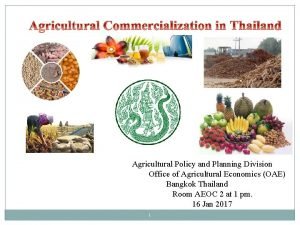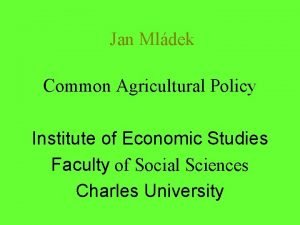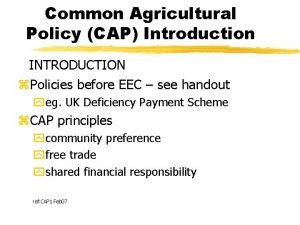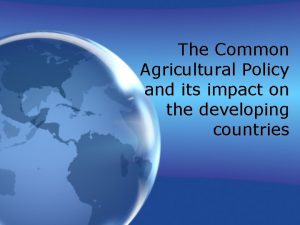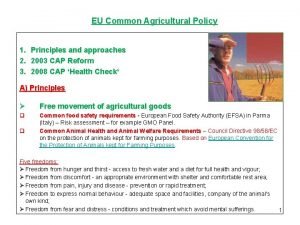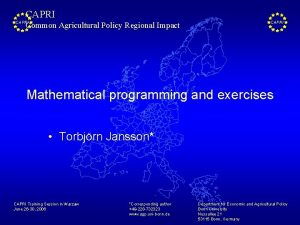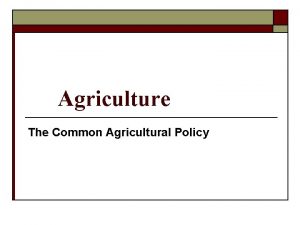The Common Agricultural Policy The Common Agricultural Policy





















- Slides: 21

The Common Agricultural Policy

The Common Agricultural Policy (CAP) • The Common Agricultural Policy (CAP) had emerged from over a decade of severe food shortages during and after World War II. Near-famine conditions in much of postwar europe made food security s national priority. • The CAP is often explained as the result of a political compromise between France and Germany: German industry would have access to the French market; in exchange, Germany would help pay for France's farmers. • France wanted to shift the cost of subsidizing France’s large and unproductive agricultural sector from the national to the European level.

The Common Agricultural Policy • The creation of a common agricultural policy was proposed in 1960 by the European Commission and the CAP mechanisms were adopted by the six founding Member States. • In 1962, the CAP came into force. General objectives of the CAP: • İncrease agricultural productivity • Ensure a fair standard of living for farmers • Stabilize agricultural markets • Gurantee regular supplies of food • Ensure reasonable prices for consumers

The Common Agricultural Policy • Three major principles had been established to guide the CAP: a. Singe market: agricultural products should be able to move freely throughout the EC • b. community preference: priority should be given to EC products over that of other countries • c. financial solidarity: the cost of the CAP should be borne by the common EC budget than by individual member states.

The Common Agricultural Policy • The basic elements of the CAP were: • Target price: The EC-wide guaranteed minimum price for a particular agricultural commodity or product • Intervention price: the price at which specially designated intervention agencies işn the member states would buy surplus products in unlimited quantities (guaranteed withdrawal from the market) • Entry price: the minimum price at which products could be imported into the EC • Levy: a duty imposed on agricultural imports to raise their price to the level of the entry price. • Refund: a rebate paid to EC exporters to bridge the gap between lower world prices and higher EC prices.

The Common Agricultural Policy • The target price was supposed to ensure that farmers had adequate incomes; • the intervention system guarantewed the sale of products regardless of market demand, • the entry price protected the EC market from heavy agreicultural imports, • and the refund was an export subsidy that enablewd farmers to sell their products on world market.

Shortcomings of the CAP reform • Guaranteed prices encouraged massive overproduction (butter mountains, wine lakes. . . ) • Big farmers produced more and earned more money, whereas small farmers who most needed assistance earned less. • Farmers used excessive amounts of herbicides, pesticides, artificial fertilizers leading to environmental problems. • Export price supports distorted world prices and undercut non-EC exporters, leading to trade disputes. • Overproduction triggered discussions of CAP reform. • The first CAP reform was made in 1984 with the quota system for milk production. But it failed to solve the problem of overproduction and reduce spending on CAP. • As part of Britain’s insistence for budgetary reform, in Fontainbleau summit, the EC leaders decided to decrese the growth of CAP expenditure.

The role of the Uruguay Round on CAP reform • Poor progress in Uruguay Round negotiations due largely disagreements over agricultural export subsidies increased international pressure on the EC to reform the CAP. • The EC was under pressure by the US, Cairns Group (an informal association of agricultural free-traders) to cut subsidies for agricultural production and exports. • Developing countries insisted on progress on agricxultural trade liberalizationin return for concessions in other sectors. For ex: India blockedagreement on intellectual property rights. • In 1987, the US demanded the EC’s elimination of all trade distorting measures within 10 years. • It is not easy to reform the CAP as member states like France is generally opposed to CAP reform.

CAP reform: the Macsharry Plan • The agricultural commissioner Ray Macharry prepared a proposal to break the link between price support and volume of food production. • The European Commission proposed the system of direct income support for farmers. It did not propose to abolish guaranteed prices. • British, Dutch and Danish ministers complained that Macsharry Plan discriminate against large producers as they have to remove large lands from production (set-asides of 15%) to get direct income. • France opposed the Macharry Plan completely. • Spain , Greece, Portugal, Ireland asked better support mechanisms for small farmers • Macharry reform was finally approved in May 1992. With the shift from price support to direct income, CAP became more expensive to finance.

Consumer and Environment Concerns • By the 1980 s and 1990 s, consumers became more concerned about food security. CAP began to be criticized due to concerns about food security and environmental degradation. • Consumers were concerned about hormones in beef and GMOs. • BSE, a disease affecting cattle appeared in Britain in the 1980 s. It led to a panic in 1996 when the British government announced a possible link between BSE and CJD disease, a human brain condition that affects mostly young people and can be fatal. • European Commission banned exports of beef from Britain to other EU member states or anywhereelse in the world. • Consumers questioned not only the safety of beef but also the safety of other products of the CAP system that emphasized mass production but paid little attention to product quality.

Enlargement and Agenda 2000 • In the late 1990 s, eastern enlargement of the EU triggered discussions on the necessity of reforming CAP. • Only 5. 3% of EU workforce was engaged in agriculture compared to over 22% of the workforce in central and eastern european countries. • The eastern enlargement would double the farm labor force and increase the agricultural land in the EU by 50%. • Moreover, agricultural prices in CEECs were much lower than in western europe. Thus, extending the CAP to new member states would necessitate either a big increase in the EU’s budget, major cuts in price supports throughout the enlarged EU, or lower subsidies for new member states than those paid to farmers in the existing member states. • Raising the EU budget and cutting the level of subsidies in the existing member states were not possible politically.

Enlargement and Agenda 2000 • The empetus for enlargement, together with growing environmental and consumer concerns led to CAP reform. The European Commission prepared the Agenda 2000 in July 1997. • The CAP component of the Agenda 2000 emphasized that the CAP should: • -improve the EU’s global competitiveness through lower prices • Guarantee the safety and quality of food to consumers • Enable a fair standard of living for farmers • Make agricultural production environmentally-friendly • Create alternative income and emplyment opportunitişes for farmers • The CAP component of the Agenda 2000 was adopted in March 1999. It limited the EU budget to 1. 27% of EU GNP.

Agenda 2000 • Agenda 2000 created a second pillar in the CAP. • The earlier CAP only dealth with support for agricultural products. But the second pillar emphasized 3 measures: agroenvironment measures, support to least favored areas, investment assistance to increase productivity and competitiveness. • Agenda 2000 highlighted rural developement: restructuring farms, diversifying product marketing.

Single Payment Scheme • The CAP was last reformed in 2003, when it was decided to lower intervention prices once more over time. However, CAP expenditures would not decrease. A new program was started: the Single Payment Scheme (SPS). • SPS offers farmers direct payments that are not linked (coupled) with the level or the type of production, but with historical production of the land between 2000 and 2002, and cross compliance to certain standards that include: fulfillment of environmental standards, and animal welfare. • SPS are subsidies, even though they are decoupled from production. • Through SPS farmers receive money independently from how much they produce or if they produce anything at all, which stabilizes their income. The decision of what and how much to produce is now more up to farmers‘ estimation of the market.

CAP activities • CAP activities are categorized into two types, called Pillar 1 and Pillar 2. • Pillar 1 covers direct payments to farmers and market measures (intervention price mechanism and import barriers). Pillar 2, which was founded in 1999, covers rural development measures. • Expenses for each fund in 2011 are outlined € 42. 9 bn for Pillar 1 and € 15. 7 bn for Pillar 2. • In 2009, CAPs main expenditures were: market interventions of € 3. 4 bn, direct payments of € 37. 8 bn, and rural development of € 13. 6 bn. • The average tariff on actual imports of agricultural goods in the EU were in 2004 22. 9%. The EU today upholds 13. 5% average value added tariffs on imports of agricultural products, matching the maximum limit allowed by the WTO. • However, it should be noted that level of tariffs for agricultural products vary greatly, some even surpass 100%. • In 2009, animal products were tariffed on average by 23. 2%, dairy products by 49. 4%, and sugar and confectioneries by 27. 5%.

CAP activities • A new issue concerning the CAP, although not directly, is the production of biofuels. • In 2008, the European Parliament and Council agreed on the Renewable Energy Directive‖, which mandates that 10% of energy used for transport will be from renewable sources before the year 2020 in every member state. • An increase in biofuel usage is to be expected, and crops used to produce them. In many member countries, tax exemption and special subsidies have already been seen, while imported biofuel from outside the Union faces tariffs. The move is thus likely to increase farmers‘ income, and as well as and land prices

Reactions against CAP • Governments criticizing the CAP generally depend much less on agriculture and are often net-contributors to the system. The biggest net-contributors in 2009 were: Germany, Belgium, Netherlands and the UK. • In 2007, the government of Sweden was the first member country to suggest a complete elimination of farm protection and subsidies, except those related to the environment. • UK has been asking for cuts in the European Common Budget, where CAP represents almost a half. The government has been making painful government-budget cuts at home and believes EU funds should take similar cuts. Still, even before the change of governments, Britain had adopted a similar position to the Swedes, calling for a phase-out of all market price support and all direct payments to farmers by 2020.

Reactions against CAP • Governments of the Netherlands, Denmark and Malta have positioned close to Sweden and UK, yet, out of the 28 states, a majority favors retaining the status quo. Particularly France is against CAP reform. • France is the largest agricultural producer in the EU with 60 billion euros worth of farm output in 2009 (18% of the EU total) • The Paris declaration in 2009 confirmed the support of 22 out of 27 EU countries for the maintainance of a strong CAP.

Reactions against CAP • The European Consumers' Organization (BEUC) raise the question why "common consumer rights" are missing, while producers are protected. They complain about high prices and tax burdens of the system and have stated that support should be slashed, so recent enlargement and international trade negotiations can be taken better advantage of. Furthermore they demand that the policy should be consumer -focused and not producer-driven • The CAP has been criticized as an 80% of the direct payments go to 20% of farms. Some of those farms are owned by big corporations and very rich individuals such as the Queen of England, which is estimated to have received over € 8 millions in CAP payments

Reactions against CAP • It has been argued that subsidies often improve incomes of landowners more than the income of the actual farmers working the land. It has also been experienced that subsidies have been taken out of farms to fund other businesses • Another criticism of the payments, has been unequal distribution, depending on the states in which farmers lived. In 2010, farmers were reported to receive € 560 per hectare in Greece to just € 90 in Latvia. • Criticism towards the CAP has also been originated outside the Union; third world countries argue that the CAP, by hurting the world economy, and especially poorer countries, are contributing to hunger and poverty.

Future reform of the CAP • In November 2010, The Commission published a communication on its vision of the CAP after 2013. • The depth of the reform will depend on EU (now composed of 28 states) internal politics, which will be constrained by conflicts of interests within the Union as well as the Doha Development round. • As a part of the Doha Round, the EU has offered to cut farm tariffs by close to 60%, and an altogether elimination of export subsidies, while the most trade distorting farm subsidies could be limited by 80%
 Ky office of ag policy
Ky office of ag policy Agricultural credit policy council
Agricultural credit policy council Sơ đồ cơ thể người
Sơ đồ cơ thể người Công thức tính độ biến thiên đông lượng
Công thức tính độ biến thiên đông lượng Các số nguyên tố
Các số nguyên tố đặc điểm cơ thể của người tối cổ
đặc điểm cơ thể của người tối cổ Tỉ lệ cơ thể trẻ em
Tỉ lệ cơ thể trẻ em Các châu lục và đại dương trên thế giới
Các châu lục và đại dương trên thế giới ưu thế lai là gì
ưu thế lai là gì Thẻ vin
Thẻ vin Môn thể thao bắt đầu bằng chữ f
Môn thể thao bắt đầu bằng chữ f Tư thế ngồi viết
Tư thế ngồi viết Cái miệng nó xinh thế chỉ nói điều hay thôi
Cái miệng nó xinh thế chỉ nói điều hay thôi Hình ảnh bộ gõ cơ thể búng tay
Hình ảnh bộ gõ cơ thể búng tay Từ ngữ thể hiện lòng nhân hậu
Từ ngữ thể hiện lòng nhân hậu Trời xanh đây là của chúng ta thể thơ
Trời xanh đây là của chúng ta thể thơ Tư thế ngồi viết
Tư thế ngồi viết Giọng cùng tên là
Giọng cùng tên là Chó sói
Chó sói Thể thơ truyền thống
Thể thơ truyền thống Hổ đẻ mỗi lứa mấy con
Hổ đẻ mỗi lứa mấy con đại từ thay thế
đại từ thay thế
